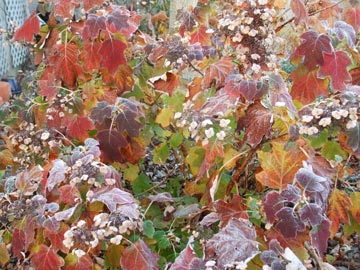When you have a small yard, you want plants that reliably strut their stuff and earn their keep without taking over. With a few wise choices, you no longer have to lust after blooming hydrangeas, fragrant roses, and cute little evergreens. Here are some suggestions:
 Sike’s Dwarf, a native oakleaf hydrangea, sports beautiful fall colors.
Sike’s Dwarf, a native oakleaf hydrangea, sports beautiful fall colors.
©Jo Ellen Meyers Sharp
Hydrangea
Look for Little Quick Fire (Hydrangea paniculata), which thrives in full sun to part shade. In the 3 to 5 foot tall and wide range. Little Quick Fire starts blooming in June and continues well into September. Its panicle flowers quickly turn from white to pink. It blooms on current season growth, so if needed, it can be pruned for shape in late winter or early summer. This type of hydrangea is sometimes pruned to be a tree form.
Native oakleaf hydrangeas (H. quercifolia) provide multiple-season beauty, from white flowers in June that turn pink as they age through the season to the leathery, wine-colored foliage from fall into winter. The bark also flakes off, called exfoliating, to reveal cinnamon colors. Grow in full to part sun. It tolerates shade. Look for Pee Wee, Sike’s Dwarf, or Ruby Slippers oakleaf hydrangeas. Each is in the 3-foot tall and 4-foot wide range. If needed, prune for shape soon after it blooms.
Rose
At Last rose (Rosa hybrid) brings fragrance and disease resistance to the garden, yet is only 30 to 36 inches tall and wide. Sunset-orange flowers bloom from late spring into fall amid glossy leaves. No pruning is needed.
Evergreen
You just can’t beat Mr. Bowling Ball arborvitae (Thuja occidentalis) for a spot of soft golden green in the garden. A slow grower, at maturity, this rounded shrub will be about 24 to 30 inches tall and wide. This sun-lover provides year-round interest, taking on a bit of a reddish hue in winter. It holds its shape beautifully. No pruning is needed.
Tips:
- Measure your space and consider the mature height and width of a plant when making your selection. Plants too big for the space become a pruning chore.
- Most shrubs do best in soil that does not stay wet. Select a plant that will thrive in your site, such as sun or shade and wet or dry soil.
- Many varieties of small shrubs can be grown in pots for the summer and transplanted to the ground in fall.
by Jo Ellen Meyers Sharp